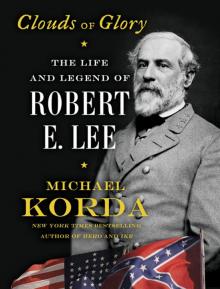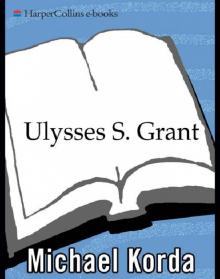- Home
- Michael Korda
Clouds of Glory Page 28
Clouds of Glory Read online
Page 28
This was not a situation Lee could accept, if only because he was dealing with the inheritance of his wife and children. To put matters in perspective, two young women were sold by the Alexandria, Virginia, slave dealer Joseph Bruin for $2,250, the equivalent of at least $40,000 in today’s money. If Lee could have sold half a dozen of the Custis slaves in nearby Alexandria he would have been able to pay off all the estate’s debts and provide the cash for his daughters’ legacies at one stroke. But neither the terms of the will nor his own honorable character would permit him to consider this. Instead, in the five years before the Custis slaves were to be emancipated Lee hired some of them out to work elsewhere. This was quite a usual practice, particularly in northern Virginia, where many plantations had a bigger slave force than was needed, but it was bitterly resented by the slaves. The Custis slaves, after all, had been at Arlington for two generations under one master. Some of the older ones had helped build the house; they had formed families and friendships; they were a community. Slaves who were hired out were suddenly separated from parents, from spouse and children, from friends—sent away to a strange place at the mercy of what might be a brutal overseer, or at the very least a taskmaster determined to get his money’s worth out of them. Most of them could not read or write, and even had they been able to, nobody would mail a letter home for them, or deliver one.
This was a sensitive subject, because in the years between 1800 and 1860 a huge involuntary migration took place. Between 800,000 and 1 million slaves were moved westward: some were taken along as their owners moved toward new land opening up on what was then the frontier in Kentucky or Tennessee, and then farther south to Mississippi and Alabama; others were sold by their owner or their owner’s heirs to the great cotton and rice plantations in the deep South. Slaves were no longer needed in large numbers in Virginia, but to the west their price rose as the need for slave labor soared. Exporting slaves became an industry—male slaves were marched in coffles of forty or fifty, handcuffed to each other in pairs, with a long chain through the handcuffs passing down the column to keep it together, closely guarded by mounted slave traders and followed by an equal number of female slaves and their children. Most of them were taken to Wheeling, Virginia, the “busiest slave port” in the United States, and from there they were transported by steamboat to New Orleans, Natchez, and Memphis.* Some were sent by sea from Virginia ports to New Orleans, where there was also a lively trade in the notorious fancy girls, a source of increasing indignation among northern abolitionists, and a strong theme running through Uncle Tom’s Cabin—one which Harriet Beecher Stowe faced unflinchingly, by nineteenth-century standards. Even if only half the slaves who traveled west were merely following their owners, like the livestock, the sale of the remaining half represents a profit of at least $500 million in mid-nineteenth-century money, or about $10 billion in today’s money. The slave trade was a hugely profitable business, and the labor of the slaves created enormous wealth.
This did not help solve Lee’s problem. He was in no way tempted to sell his father-in-law’s slaves; nor could he have done so—on the contrary, he and Mary went to great effort to fulfill the terms of the will. Still, the effect of this great forced migration on the slaves themselves cannot be underestimated. Ignorant and illiterate some of them might be, but they knew what was happening, and it frightened them—rightly so, since if they were sold south to the new plantations they would not only be separated from everything and everyone they knew, but very likely worked to death under brutal conditions. Lee simply failed to understand the enormous sense of fragility in slave communities like those of Arlington, and the fear of being sent away. When slaves were hired out, they did not know where they were going, or for how long, and feared that instead they might end up on the auction block. In fact it was common practice to hire out the more troublesome slaves and send them somewhere farther away from the temptation of escaping than northern Virginia.
This was a practical factor of slave ownership with which Lee was familiar, and he does not seem to have ignored it in choosing which of the Custis slaves to hire out. However, it was only one of the causes of growing resentment among the slaves, who had “the general impression” they would be freed on Mr. Custis’s death—an impression for which Mr. Custis himself was no doubt to blame, since he probably could not be bothered to explain that their emancipation would not in fact take place until his estate had been settled. It cannot have helped that Lee was the proverbial new broom that sweeps clean. His goal was worthy—to restore his late father-in-law’s properties and make them profitable for his own wife and children—but this could be done only by working the slaves harder and by eliminating the slackness, the lack of supervision, and the small privileges that Mr. Custis had permitted for many years. The fact that Lee was a former superintendent of West Point, accustomed to having his orders obeyed crisply and without question, probably did not help either—the Custis slaves were not cadets.
From the very beginning Lee had problems with runaways who believed they should have been freed, and who resented his strictness. Each one required Lee to advertise for his or her return, and pay a reward when the slave was brought back. Whether Lee punished the runaways except by hiring them out to someone farther south or west, who might take harsher measures to prevent their escape, is unknown. Elizabeth Brown Pryor, in her book on Lee’s letters, Reading the Man, speculates that “a whipping post [still] stood” at Arlington, as it did outside the slave quarters on many other plantations, but if so it may have been merely symbolic—although nothing is more powerful than a certain kind of symbol.
The Lees themselves complained that abolitionists were “lurking” around Arlington, urging the slaves to demand their freedom. Arlington and Alexandria were only a stone’s throw from Washington, D.C., where there was a substantial community of freed blacks and intense abolitionist activity, so much so that slave owners in the area hesitated to send their slaves there on errands, or to hire them out in the city. One of the major routes of the Underground Railroad involved smuggling fugitive slaves out of the District of Columbia and on to the free states of Pennsylvania and New Jersey.
If the Lees, living so close to Washington, felt besieged, it was not without cause. Lee was not yet famous, but as the last living link to George Washington Mr. Custis had been; it was widely supposed by abolitionists that he had freed his slaves, and that Lee was nevertheless keeping them in bondage. Lee was chagrined, although certain he was not only acting within his rights but, more important, doing the right thing. He and Mary set up a school (against state law, which forbade teaching slaves to read and write) to better prepare the slaves for emancipation, and Lee struggled to pay off the debts and put the widespread Custis plantations on a sound business footing, without which he could not free the slaves within the five-year period stipulated in the will; but the only result was an increasingly sullen and uncooperative workforce and a buzz of scurrilous stories about the Lees, which reached their peak in the spring of 1859 with the escape of three Arlington slaves: Wesley Norris, his sister Mary, and a cousin.
With or without the help of abolitionists, the three made it as far as Maryland, where they “were apprehended and thrown into prison,” and after two weeks in a “slave jail” they were returned to Arlington. According to Norris’s account, when they were brought before Lee, “he told us he would teach us a lesson we would never forget.” What happened then is a matter of dispute. Norris would later claim that Lee ordered all three to be tied to posts in the barn and stripped; that the two men were then whipped fifty times, the woman twenty; and that afterward their backs were washed with brine to intensify the pain of the lacerations—all this in Lee’s presence. The two men were then sent to jail for a week and thereafter hired out as farmworkers farther south; the woman was hired out to Richmond.
Allegations about Lee’s treatment of his slaves reached New York City quickly, in the form of two anonymous “letters to the editor” published on the same day.
To the Editor of the N.Y. Tribune.
Sir: It is known that the venerable George Washington Parke Custis died some two years ago; and the same papers that announced his death announced also the fact that on his deathbed he liberated his slaves. The will, for some reason, was never allowed any publicity, and the slaves themselves were cajoled along with the idea that some slight necessary arrangements were to be made, when they would all have their free papers. Finally they were told five years must elapse before they could go. Meantime they have been deprived of all means of making a little now and then for themselves, as they were allowed to do during Mr. Custis’s life, have been kept harder at work than ever, and part of the time have been cut down to half a peck of unsifted meal a week for each person, without even their fish allowance. . . .
Some three or four weeks ago, three, more courageous than the rest, thinking their five years would never come to an end, came to the conclusion to leave for the North. They were most valuable servants, but they were never advertised, and there was no effort made to regain them which looks exceedingly as though Mr. Lee, the present proprietor, knew he had no lawful claim to them. They had not proceeded far before their progress was intercepted by some brute in human form, who suspected them to be fugitives, and probably wished a reward. They were lodged in jail, and frightened into telling where they started from. Mr. Lee was forthwith acquainted with their whereabouts, when they were transported back, taken into a barn, stripped, and the men received thirty and nine lashes each, from the hands of the slave-whipper, when he refused to whip the girl, and Mr. Lee himself administered the thirty and nine lashes to her. They were then sent to Richmond jail, where they are now lodged. . . .
The second letter, rather shorter, read:
To the Editor of The N.Y. Tribune.
Sir: I live one mile from the plantation of George Washington P. Custis, now Col. Lee’s, as Custis willed it to Lee. All the slaves on this estate, as I understand, were set free at the death of Custis, but are now held in bondage by Lee. . . . Custis had fifteen children by his slave women. I see his grandchildren every day; they are of a dark yellow. Last week three of the slaves ran away; an officer was sent after them, overtook them nine miles this side of Pennsylvania, and brought them back. Col. Lee ordered them whipped. They were two men and one woman. The officer whipped the two men, and said he would not whip the woman, and Col. Lee stripped her and whipped her himself. These are facts as I learn from near relatives of the men whipped. . . .
Yours,
A Citizen
Although these letters are dismissed by most of Lee’s biographers as exaggerated, or simply as unfounded abolitionist propaganda, it is hard to ignore them. The second one, from “A Citizen,” reads as if it might have been written by an envious or malicious neighbor—one who claims to live only “one mile” away from Arlington and to see the slaves “every day”—rather than by an abolitionist propagandist. The reference to the late Mr. Custis having fathered fifteen “dark yellow” children by his slave women must have been mortifying to Mrs. Lee, and scarcely less so to Lee, but the longer letter, which was signed “A,” is actually more damaging to Lee’s reputation, and also full of small details that can have been obtained only from the Arlington slaves themselves. In any case, Lee decided not to reply, and that was surely the right decision. As he wrote to his oldest son Custis, “The New York Tribune has attacked me for my treatment of your grandfather’s slaves, but I shall not reply. He has left me an unpleasant legacy.”
It seems incongruously out of character for Lee to have whipped a woman slave himself, particularly one stripped to the waist, and that charge may have been a flourish added by the two correspondents; interestingly enough, it was not repeated by Wesley Norris when his account of the incident was published in 1866. After Norris’s account appeared Lee wrote to an acquaintance, “No servant, soldier or citizen . . . can with truth charge me with bad treatment,” which is as close he ever came to denying the accusations. Brown speculates with some reason that the definition of “bad treatment” is elastic and must take into account the difference in attitude toward corporal punishment in our day and the mid-nineteenth century. The whipping of disobedient or runaway slaves was not necessarily considered “cruel or unusual punishment” in most of the South—this was still, after all, an age when children were often whipped in school and at home. “Spare the road and spoil the child,” remained a widespread belief about child rearing. Lee did not use corporal punishment on any of his children—he was the most benign of parents, who relied on moral suasion and setting a good example to instruct his children—but in the mid-nineteenth century people were not squeamish about corporal punishment, and Lee may very well have been infuriated by the way the Custis slaves were resisting his reforms and running away. It was humiliating and expensive for him to search them down and get them back, and he may have felt it was time to set a stern example. Whipping was far from being unusual: Virginia law actually stipulated whipping slaves for certain offenses. So Lee was well within his rights, whatever we may think of the incident, and although it seems unlikely that he would have done any of the whipping himself, he may not have flinched from observing it to make sure his orders were carried out exactly.
Lee was never an enthusiast of slavery, and his experience with the Custis slaves further soured him on the institution. He and Mary quietly went on with their plan to educate the Custis slaves, until, one after the other, the Custis properties were overrun by Union troops. The Lees met their obligation to free the Custis slaves within the five years stipulated by Mr. Custis on December 29, 1862, only three months after President Lincoln had announced that he would sign the Emancipation Proclamation, by which time most of the Custis slaves were behind Union lines.
It is hard to know what to make of this incident, or of the slightly different accounts it generated, except to conclude that it was a good example of the moral ambiguities and dilemmas slavery produced for those who owned slaves, even those who, like Lee, were among the noblest and most chivalrous citizens in the South. Wesley Norris’s account appears too specific to be a total invention, and although he differs from the two letters to the Tribune in details—the number of lashes administered and Lee’s personally whipping Mary Norris—it remains possible that something like this took place in Arlington in the spring of 1859. Ironically, Norris ended up working at Arlington in the National Cemetery after the war, and his sister found employment “by the French Minister at Washington,” a happy outcome for two of the Arlington slaves. As to the final judgment of the episode, one must look to the choice of verdicts in the old Scottish courts, where juries could choose one of three verdicts, “Guilty,” “Not guilty,” and “Not proven,” the last meaning that the jury had its doubts about the accused, but was not convinced by the facts presented to it by the prosecution.
Lee continued to devote his time to repairing Arlington and trying to make the Custis properties self-supporting, if not profitable, with a short break to sit on a court-martial in New York. His military career was more or less suspended at his own request, although General Scott offered him an appointment as his own “military secretary,” a significant sign of the trust and confidence Scott had in Lee. Lee declined the post because “he did not wish to return to staff duty,” and perhaps also because he thought that promotion would be even slower there than as commander of a cavalry regiment in the West. In mid-October, he had the good fortune to be the only officer of the appropriate rank and experience to be placed in command of the forces sent to Harpers Ferry. Then, to his dismay, he was obliged to remain in Arlington until mid-February 1860, in order to testify before the Senate investigation of the Harpers Ferry incident, though he was not asked any questions of real importance.
He was impatient to resume command of the Second Cavalry, but he can hardly have been unaware of the growing discord in the country. His numerous relatives in Virginia would have discussed the southerners’ rising resentment against northern
abolitionist sentiment, and Lee’s fellow officers can hardly have failed to bring the subject up in his presence—indeed it was almost the only subject of conversation in the months that separated John Brown’s raid on Harpers Ferry and the firing on Fort Sumter. Talk of secession was widespread, and Lee, though he was wise enough to keep his opinions about the politics of the day to himself, was only too conscious of the difficulties that would face him as an officer of the U.S. Army if he was forced to chose between his country and his state.
He left Arlington on February 10 and arrived in San Antonio on February 19, fast traveling for the day. In addition to command of his regiment, he was “assigned temporary command of the Department of Texas,” since he was for the moment the highest-ranking officer in the state, and settled down, perhaps with some relief, to the problems of Indian raids and Mexican bandits.
CHAPTER 6
1861—“The Thunder of the Captains and the Shouting”
Douglas Southall Freeman, perhaps preeminent among Lee’s many biographers, whose four-volume biography, published in 1934 and 1935, was for many years the gold standard on the subject, goes a lot further in expressing enthusiasm for secession than Lee himself ever seems to have done. Freeman writes of Lee at the beginning of 1860: “Like the fated victim of a Greek tragedy, he was coming under forces that he could not control, forces against which it was futile for him even to struggle. . . . The development of the concept of a nation had eclipsed in their minds the older principle that a man’s first duty was to his state. It had never been so with Lee. . . . The spirit of Virginia had been alive in his heart every hour of his life. . . . Having ploughed her fields, he had a new sense of oneness with her. He was a United States officer who loved the Army and had pride in the Union, but something very deep in his heart kept him mindful that he had been a Virginian before he had been a soldier.”

 Passing
Passing Another Life
Another Life Clouds of Glory
Clouds of Glory Hero: The Life and Legend of Lawrence of Arabia
Hero: The Life and Legend of Lawrence of Arabia Cat People
Cat People Hero
Hero With Wings Like Eagles: A History of the Battle of Britain
With Wings Like Eagles: A History of the Battle of Britain Ulysses S. Grant
Ulysses S. Grant